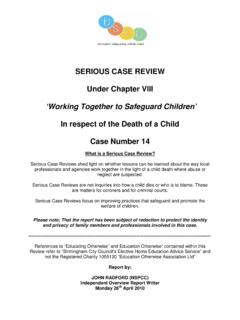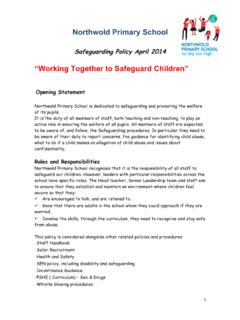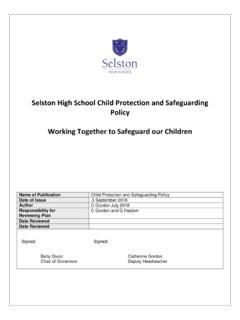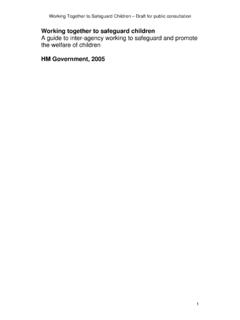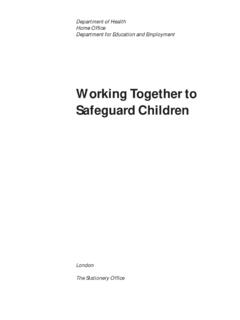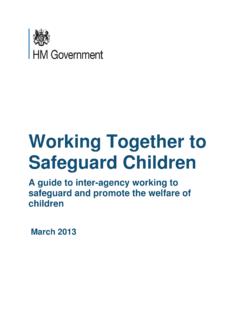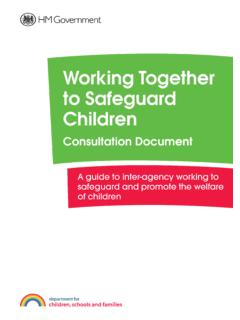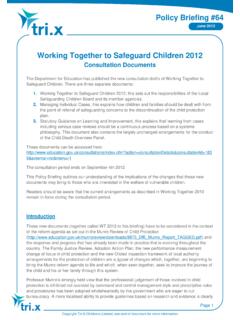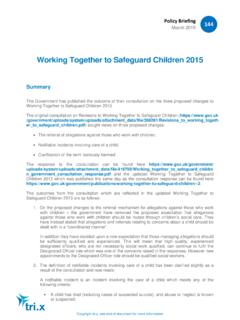Transcription of Child Death Review Process - Devine v4
1 Argument & Critique 1 The role of parents in the Child Death Review Process By Dr Lauren Devine University of the West of England Bibliographical Note Dr Lauren Devine (Hons) MA PGCertHE FHEA Barrister, is a Senior Lecturer at the University of the West of England, Director of the Interdisciplinary and Expert Evidence Network ( ) and Principal Investigator for the ESRC funded project Rethinking Child Protection Strategy (ES/M000990/1). , @DrLaurenDevine Abstract This article considers whether evidential and procedural issues identified in relation to public family law social work assessment of families can be used to further understanding of the Child Death Review Process . The Process is an under-researched but important aspect of statutory family assessment. Pre-litigation stages of family investigation, particularly in relation to Child protection and safeguarding are undertaken within the Framework for the Assessment of Children in Need and their Families, set out in working together to Safeguard Children.
2 The Child Death Review Process , also in working together to Safeguard Children is applied in cases of Child deaths categorised as sudden and unexpected . Assessment of bereaved parents is particularly sensitive and highlights the problems of mixing investigatory assessment with measures intended to be supportive. This paper questions the function of the Child Death Review Process , asking whether it forms part of a drift towards increasingly intrusive state surveillance of families and particularly parents, or is an attempt to work together with parents following bereavement. If it is an investigatory Process there are ramifications for subsequent decision making, including decisions made by courts in public family law or criminal proceedings. A clearer framework for assessment and inclusion of parents as part of (as opposed to subjects of) the Process is indicated. Alternatively the Process should be removed from working together and carried out within the criminal justice framework, the public health framework and the Coroner s framework.
3 Key words Child Death Review Process , working together to Safeguard Children, public family law, social work assessment, Child protection, safeguarding, BRI Public Inquiry. Argument & Critique 2 The role of parents in the Child Death Review Process Introduction Drawing on an earlier paper presented to the Sudden & Unexpected Deaths in Infancy (SUDI) Conference ( Devine , 2014), the current paper discusses a number of issues in relation to the Child Death Review Process . The discussion includes: the impact of the Child Death Review Process on the justice system as a pre-litigation investigation Process , its inclusion in the post-refocusing grouping of welfare and policing assessments into a general assessment framework set out in working together to Safeguard Children (Department for Education, 2013), the influence of the abuse eradication narrative, and the role of Public Inquiries and Serious Case Reviews.
4 Aspects of public law family assessment have become progressively more invasive into private family life since the Children Act 1989. Although the remit of the Child Death Review Process theoretically includes investigation of all circumstances surrounding a Child s Death , the inference is that its focus is an investigation of parental conduct by virtue of its inclusion in the English government s statutory guidance document working together to Safeguard Children (Department for Education, 2013). This theoretically places it within the remit of Child protection and safeguarding with associated data sharing implications. The question, however, of where in the three domains of safeguarding, clinical/social service organisation and delivery, and public health professionals, the Child Death Review Process is located is unclear: ..there is a bit of a mismatch now between whether we are reviewing Child deaths from a sort of social and safeguarding implications of them, or whether it is safeguarding thing.
5 Or, because most obviously 35-40% of them are going to be neonatal, premature babies, all of them, that are expected deaths and should we be reviewing them. I don t know whether you can build it into this? Whether that is a good use of time or whether that should be done somewhere else? (Kurinczuk and Knight, 2013:38-39). The Child Death Review Process is a unique form of public family assessment ensuring that every bereaved family is categorised as known to local authority Children s Services Departments either through direct Child protection or safeguarding referral as part of the Child Death Review Process or simply by virtue of data recording with the Local Safeguarding Children Board (LSCG) and the Child Death Overview Panel (CDOP) (Kurinczuk and Knight, 2013). The enabling legislation for the Child Death Review Process is contained in section 14(2) of the Children Act 2004 and was introduced by statutory instrument in 2006.
6 Six years after the enabling legislation was enacted the Child Death Review Process was included in the statutory guidance working together to Safeguard Children (Department of Health, 2010a:215). The statutory guidance is intended to provide a framework for assessment where professionals work together with families at the same time as investigating them. Unsurprisingly this Process is reported as being a cause of conflict and trauma for families as well as creating a difficult position for professionals ( Devine , 2015). Families experiences of working with professionals during and after assessment, even in situations intended to be consensual almost unanimously report a negative experience. Parents and their children report long term trauma caused by the strain of allegations, ongoing suspicions, and the need Argument & Critique 3 to comply with social work and other professional requirements in respect of aspects of private family life (Butler-Sloss, 1988; Schultz, 1989:37; Richardson, 1990; Luza & Ortiz, 1991:108; Wakefield & Underwager, 1994; Prosser, 1995:10; Dale et al, 2005; Jones, 2001:1395; Prosser & Lewis, 1992:20).
7 This trauma is not recognised in the statutory guidance, raising a question over the suitability of the inclusion of the Child Death Review Process in it given that bereaved parents are in a particularly vulnerable position. It is not suggested that a thorough investigation of any sudden and unexpected Death , whether in infancy, childhood or adulthood, is contra-indicated. However the justification and rationale for the need for the Child Death Review Process is not as clearly indicated: the existing criminal justice, clinical governance and Coroner s Inquest framework all provide mechanisms for establishing the circumstances surrounding a Death . Recent research by the Department for Education raises a number of issues about how the Process is operating, particularly in relation to the accuracy and consistency of information, and its recording: ..I wonder how accurate this data is because nobody is entering it in the same way.
8 (Kurinczuk and Knight, 2013:26). Yes. I think at the moment it is done so badly and so inconsistently that it is a waste of time and I think if you wanted to do this properly, which I think if you want any sensible learning from it, you should be trying to do it properly and given the amount of money that is thrown at think that the way that it is done at the moment is so haphazard, it is so idiosyncratic. (Kurinczuk and Knight, 2013:26). The depth of the investigation carried out during the Child Death Review Process was questioned: ..I know, because of the work I do that many authorities are actually filling those returns in after a very minimal Review . (Kurinczuk and Knight, 2013:26). The Child Death Review Process seems to be a return to the pre-refocusing approach of suspecting parents of wrongdoing until they are screened out of suspicion. In Gibbons et al. s research (Gibbons et al.)
9 1995) it was identified that families were filtered out of a Child protection response to referral as opposed to being filtered in . This prompted a shift in assessment practice away from this policy, recognising it was causing unnecessary trauma to families. Those who simply needed support services based on need as opposed to parental insufficiency or Child abuse were unnecessarily drawn into an investigatory Process . The Process of being filtered out was precisely what was seen as being so traumatic to families who were largely found to simply need access to restricted welfare services. A return to this position seems contra-indicated as it is already known to yield a high false positive rate and a high traumatic cost to families. Even allowing for the different operational framework to other forms of family assessment used in the Child Death Review Process , bereaved parents may form a category of parents least able to cope with it.
10 Their lack of direct involvement as participants does not acknowledge the ethos of working together and may be a trigger to increase their trauma. Practitioners responding on behalf of CDOP have reported concerns about the emotional implications of the investigation, stating inter alia that: Argument & Critique 4 It is disrespectful to be honest for the children who have died, if you want to put it in bleak and emotional terms. (Kurinczuk and Knight, 2013:26). The key difference in assessment under the Child Death Review Process when compared with other assessments under working together to Safeguard Children is it is never consensual and does not aim to include parents as partners in the Process . In non-bereaved families the trigger for family assessment is a referral to Children s Services Departments. The Child Death Review Process is triggered by the Death of a Child .
